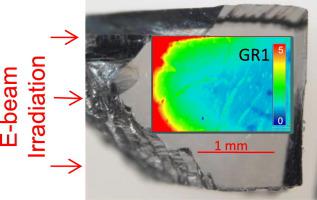当前位置:
X-MOL 学术
›
Diam. Relat. Mater.
›
论文详情
Our official English website, www.x-mol.net, welcomes your
feedback! (Note: you will need to create a separate account there.)
Spatial distribution of defects in natural type IIb diamond after irradiation and annealing
Diamond and Related Materials ( IF 4.3 ) Pub Date : 2020-11-01 , DOI: 10.1016/j.diamond.2020.108034 Sally Eaton-Magaña , Troy Ardon
Diamond and Related Materials ( IF 4.3 ) Pub Date : 2020-11-01 , DOI: 10.1016/j.diamond.2020.108034 Sally Eaton-Magaña , Troy Ardon

|
Abstract Natural blue diamonds are among the rarest and most valuable of gemstones; however, they are occasionally treated by a variety of methods to improve the color or in attempts to obscure the evidence of treatment. In this study, two sections were cut from a rough naturally sourced type IIb diamond. One was subjected to electron irradiation along one edge. Subsequently, both were isochronally annealed from 300 °C to 1200 °C and the optical defects were documented by changes in infrared (IR) absorption and photoluminescence spectroscopic mapping. The thermal behavior of these centers (TR12, 3H, NV0, GR1, 648.2 and 776.4 nm centers among others) along with their spatial distribution in the irradiated and non-irradiated diamond provided additional insights into their configuration. After irradiation, the uncompensated boron concentration as determined by IR spectroscopy for this sample showed a pronounced decrease particularly at positions close to the irradiation edge. This uncompensated boron decreased further with low temperature annealing (300–600 °C) principally due to interstitial migration. At temperatures >600 °C, the uncompensated boron concentration rebounded due to vacancy migration that likely depletes or annihilates compensating defects. Among the photoluminescence (PL) defects, the 3H center (ZPL = 503.5 nm) showed a much greater thermal stability in the irradiated sample compared to its non-irradiated counterpart.
中文翻译:

天然IIb型金刚石辐照退火后缺陷空间分布
摘要 天然蓝钻是最稀有、最有价值的宝石之一;然而,它们偶尔会通过各种方法进行处理以改善颜色或试图掩盖处理的证据。在这项研究中,从天然来源的 IIb 型钻石原石上切下了两个部分。一个沿一侧受到电子辐照。随后,两者都从 300 °C 到 1200 °C 等时退火,并通过红外 (IR) 吸收和光致发光光谱映射的变化记录了光学缺陷。这些中心(TR12、3H、NV0、GR1、648.2 和 776.4 nm 中心等)的热行为以及它们在辐照和未辐照钻石中的空间分布提供了对其配置的额外见解。辐照后,该样品的红外光谱测定的未补偿硼浓度显示出明显的降低,尤其是在靠近辐照边缘的位置。这种未补偿的硼随着低温退火(300-600°C)进一步减少,主要是由于间隙迁移。在温度 > 600 °C 时,未补偿的硼浓度由于可能耗尽或消除补偿缺陷的空位迁移而反弹。在光致发光 (PL) 缺陷中,3H 中心 (ZPL = 503.5 nm) 在受辐照样品中显示出比未受辐照样品更高的热稳定性。这种未补偿的硼随着低温退火(300-600°C)进一步减少,主要是由于间隙迁移。在温度 > 600 °C 时,未补偿的硼浓度由于可能耗尽或消除补偿缺陷的空位迁移而反弹。在光致发光 (PL) 缺陷中,3H 中心 (ZPL = 503.5 nm) 在受辐照样品中显示出比未受辐照样品更高的热稳定性。这种未补偿的硼随着低温退火(300-600°C)进一步减少,主要是由于间隙迁移。在温度 > 600 °C 时,未补偿的硼浓度由于可能耗尽或消除补偿缺陷的空位迁移而反弹。在光致发光 (PL) 缺陷中,3H 中心 (ZPL = 503.5 nm) 在受辐照样品中显示出比未受辐照样品更高的热稳定性。
更新日期:2020-11-01
中文翻译:

天然IIb型金刚石辐照退火后缺陷空间分布
摘要 天然蓝钻是最稀有、最有价值的宝石之一;然而,它们偶尔会通过各种方法进行处理以改善颜色或试图掩盖处理的证据。在这项研究中,从天然来源的 IIb 型钻石原石上切下了两个部分。一个沿一侧受到电子辐照。随后,两者都从 300 °C 到 1200 °C 等时退火,并通过红外 (IR) 吸收和光致发光光谱映射的变化记录了光学缺陷。这些中心(TR12、3H、NV0、GR1、648.2 和 776.4 nm 中心等)的热行为以及它们在辐照和未辐照钻石中的空间分布提供了对其配置的额外见解。辐照后,该样品的红外光谱测定的未补偿硼浓度显示出明显的降低,尤其是在靠近辐照边缘的位置。这种未补偿的硼随着低温退火(300-600°C)进一步减少,主要是由于间隙迁移。在温度 > 600 °C 时,未补偿的硼浓度由于可能耗尽或消除补偿缺陷的空位迁移而反弹。在光致发光 (PL) 缺陷中,3H 中心 (ZPL = 503.5 nm) 在受辐照样品中显示出比未受辐照样品更高的热稳定性。这种未补偿的硼随着低温退火(300-600°C)进一步减少,主要是由于间隙迁移。在温度 > 600 °C 时,未补偿的硼浓度由于可能耗尽或消除补偿缺陷的空位迁移而反弹。在光致发光 (PL) 缺陷中,3H 中心 (ZPL = 503.5 nm) 在受辐照样品中显示出比未受辐照样品更高的热稳定性。这种未补偿的硼随着低温退火(300-600°C)进一步减少,主要是由于间隙迁移。在温度 > 600 °C 时,未补偿的硼浓度由于可能耗尽或消除补偿缺陷的空位迁移而反弹。在光致发光 (PL) 缺陷中,3H 中心 (ZPL = 503.5 nm) 在受辐照样品中显示出比未受辐照样品更高的热稳定性。









































 京公网安备 11010802027423号
京公网安备 11010802027423号